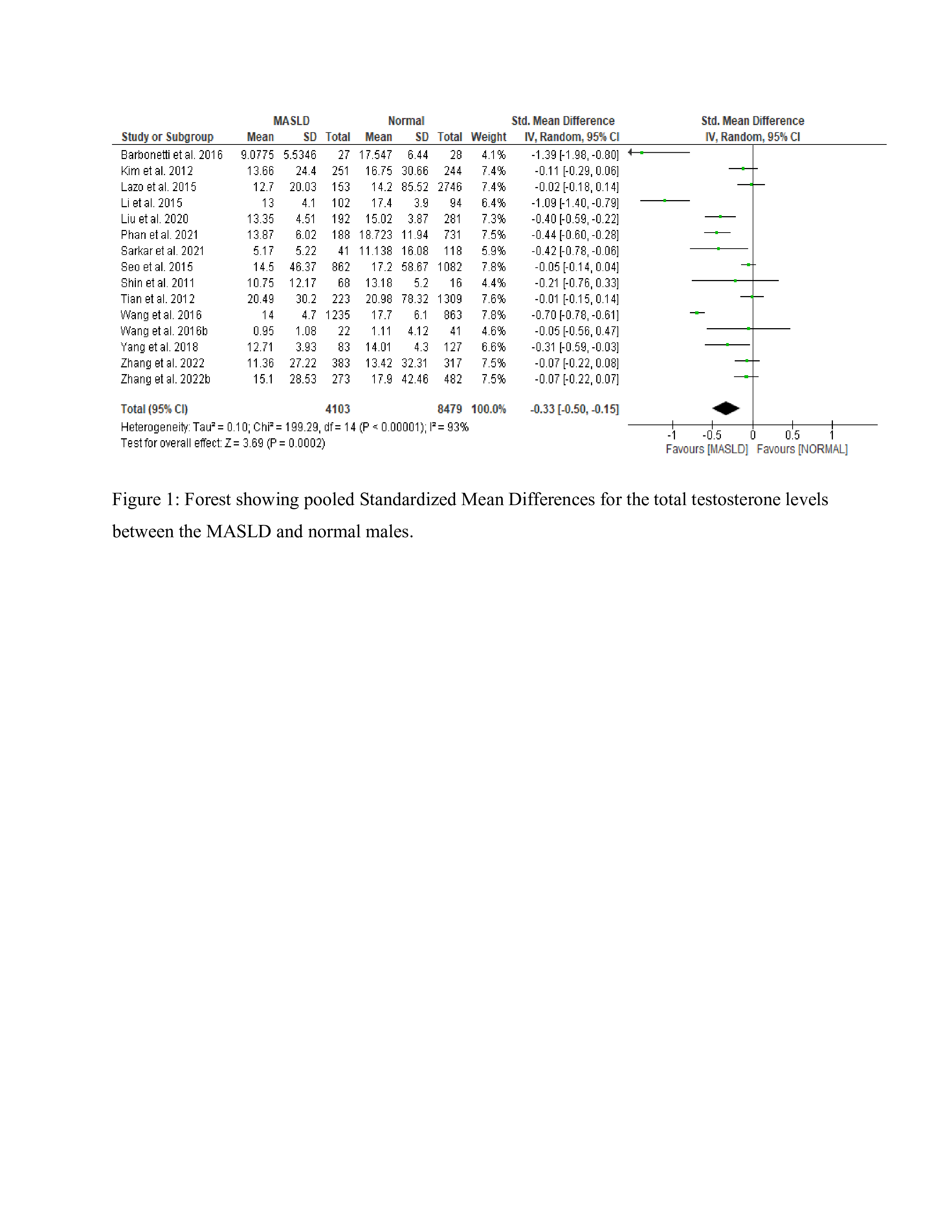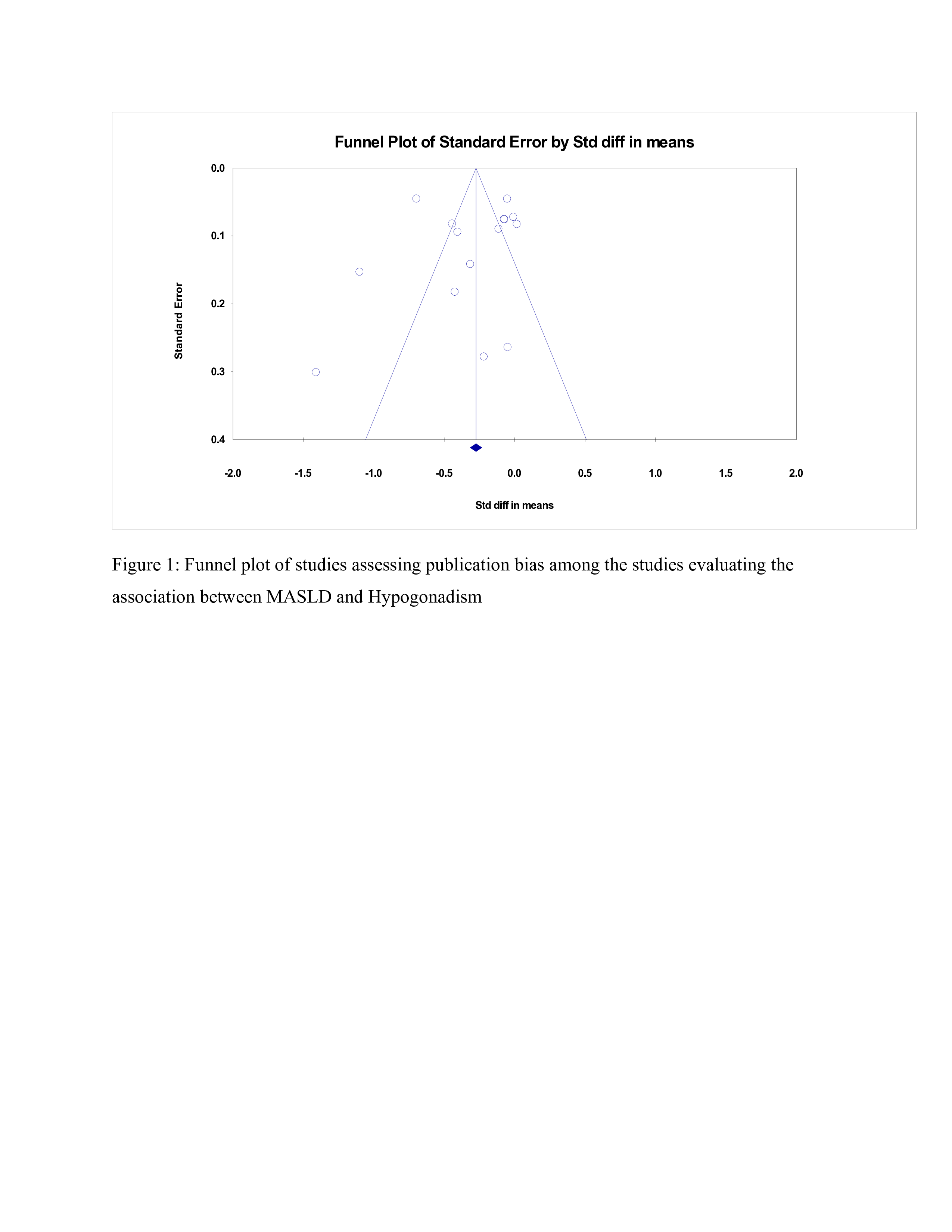Tuesday Poster Session
Category: Liver
P5819 - The Association Between Metabolic Dysfunction-Associated Steatotic Liver Disease and Hypogonadism in Male Patients: A Systematic Review and Meta-Analysis
Tuesday, October 28, 2025
10:30 AM - 4:00 PM PDT
Location: Exhibit Hall

Natchaya Polpichai, MD
Division of gastroenterology/hepatology, Medical College of Georgia at Augusta University
Chicago, IL
Presenting Author(s)
Natchaya Polpichai, MD1, Panisara Fangsaard, MD2, Pojsakorn Danpanichkul, MD3, Sakditad Saowapa, MD3, Emily Shu-Yen Chan, MD4, Noppachai Siranart, MD5, Apichat Kaewdech, MD6
1Division of gastroenterology/hepatology, Medical College of Georgia at Augusta University, Chicago, IL; 2Bassett Medical Center, Cooperstown, NY; 3Department of Internal Medicine, Texas Tech University Healt, Lubbock, TX; 4Weiss Memorial Hospital, Chicago, IL; 5Brigham and Women's Hospital, Harvard Medical School, Boston, MA; 6Prince of Songkla University, Hatyai, Songkhla, Thailand
Introduction: Metabolic Dysfunction-Associated Steatotic Liver Disease (MASLD) represents a significant global health concern, often associated with various metabolic disorders. Recent research has highlighted a potential association between MASLD and hypogonadism in males, characterized by decreased reproductive hormone levels. This study aims to explore the association between MASLD and hypogonadism in male patients.
Methods: A systematic review and meta-analysis were conducted using articles from PubMed, PMC, Scopus, Web of Science, and the Cochrane database. REVMAN 5.4 statistical software was employed for the meta-analysis, utilizing a random-effects model, 95% confidence interval, and standardized mean differences. Study quality was assessed using the AXIS checklist for cross-sectional studies.
Results: Fifteen studies involving 12,582 males with or without MASLD underwent quality appraisal. The primary outcome was the mean total testosterone levels in each cohort. Analysis revealed a statistically significant reduction in total mean testosterone levels among MASLD patients compared to those without MASLD (SMD -0.33 nmol/L, 95% CI -0.50, -0.15, P=0.0002). Significant heterogeneity (I2=92%, P< 0.00001) was observed, attributed to differences in study designs and proportions.
Discussion: This investigation establishes a significant association between MASLD and low testosterone levels in male patients.

Figure: Figure 1. Forest showing pooled Standardized Mean Differences for the total testosterone levels between the MASLD and normal males.

Figure: Figure 2. Funnel plot of studies assessing publication bias among the studies evaluating the association between MASLD and Hypogonadism
Disclosures:
Natchaya Polpichai indicated no relevant financial relationships.
Panisara Fangsaard indicated no relevant financial relationships.
Pojsakorn Danpanichkul indicated no relevant financial relationships.
Sakditad Saowapa indicated no relevant financial relationships.
Emily Shu-Yen Chan indicated no relevant financial relationships.
Noppachai Siranart indicated no relevant financial relationships.
Apichat Kaewdech indicated no relevant financial relationships.
Natchaya Polpichai, MD1, Panisara Fangsaard, MD2, Pojsakorn Danpanichkul, MD3, Sakditad Saowapa, MD3, Emily Shu-Yen Chan, MD4, Noppachai Siranart, MD5, Apichat Kaewdech, MD6. P5819 - The Association Between Metabolic Dysfunction-Associated Steatotic Liver Disease and Hypogonadism in Male Patients: A Systematic Review and Meta-Analysis, ACG 2025 Annual Scientific Meeting Abstracts. Phoenix, AZ: American College of Gastroenterology.
1Division of gastroenterology/hepatology, Medical College of Georgia at Augusta University, Chicago, IL; 2Bassett Medical Center, Cooperstown, NY; 3Department of Internal Medicine, Texas Tech University Healt, Lubbock, TX; 4Weiss Memorial Hospital, Chicago, IL; 5Brigham and Women's Hospital, Harvard Medical School, Boston, MA; 6Prince of Songkla University, Hatyai, Songkhla, Thailand
Introduction: Metabolic Dysfunction-Associated Steatotic Liver Disease (MASLD) represents a significant global health concern, often associated with various metabolic disorders. Recent research has highlighted a potential association between MASLD and hypogonadism in males, characterized by decreased reproductive hormone levels. This study aims to explore the association between MASLD and hypogonadism in male patients.
Methods: A systematic review and meta-analysis were conducted using articles from PubMed, PMC, Scopus, Web of Science, and the Cochrane database. REVMAN 5.4 statistical software was employed for the meta-analysis, utilizing a random-effects model, 95% confidence interval, and standardized mean differences. Study quality was assessed using the AXIS checklist for cross-sectional studies.
Results: Fifteen studies involving 12,582 males with or without MASLD underwent quality appraisal. The primary outcome was the mean total testosterone levels in each cohort. Analysis revealed a statistically significant reduction in total mean testosterone levels among MASLD patients compared to those without MASLD (SMD -0.33 nmol/L, 95% CI -0.50, -0.15, P=0.0002). Significant heterogeneity (I2=92%, P< 0.00001) was observed, attributed to differences in study designs and proportions.
Discussion: This investigation establishes a significant association between MASLD and low testosterone levels in male patients.

Figure: Figure 1. Forest showing pooled Standardized Mean Differences for the total testosterone levels between the MASLD and normal males.

Figure: Figure 2. Funnel plot of studies assessing publication bias among the studies evaluating the association between MASLD and Hypogonadism
Disclosures:
Natchaya Polpichai indicated no relevant financial relationships.
Panisara Fangsaard indicated no relevant financial relationships.
Pojsakorn Danpanichkul indicated no relevant financial relationships.
Sakditad Saowapa indicated no relevant financial relationships.
Emily Shu-Yen Chan indicated no relevant financial relationships.
Noppachai Siranart indicated no relevant financial relationships.
Apichat Kaewdech indicated no relevant financial relationships.
Natchaya Polpichai, MD1, Panisara Fangsaard, MD2, Pojsakorn Danpanichkul, MD3, Sakditad Saowapa, MD3, Emily Shu-Yen Chan, MD4, Noppachai Siranart, MD5, Apichat Kaewdech, MD6. P5819 - The Association Between Metabolic Dysfunction-Associated Steatotic Liver Disease and Hypogonadism in Male Patients: A Systematic Review and Meta-Analysis, ACG 2025 Annual Scientific Meeting Abstracts. Phoenix, AZ: American College of Gastroenterology.
